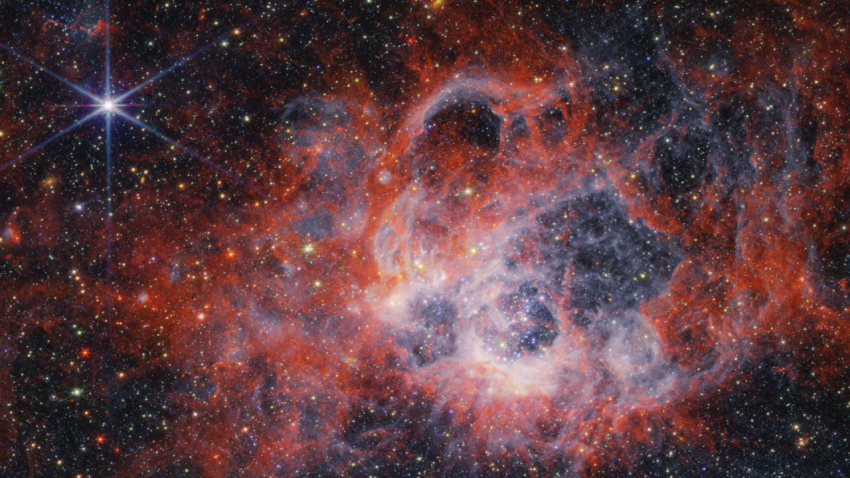New Discovery of Dormant Galaxies in the Early Universe
Astronomers have made a groundbreaking discovery by identifying over a dozen “dormant” galaxies that ceased their star formation within the first billion years after the Big Bang. This finding, made possible through data from the James Webb Space Telescope (JWST), offers valuable insights into the evolution of early galaxies and the processes that influence star formation.
The reasons behind a galaxy’s dormancy are varied. One key factor is the presence of supermassive black holes at their centers. These cosmic giants emit intense radiation that heats and depletes the cold gas essential for forming new stars. Additionally, neighboring galaxies can strip away or heat this gas, leading to a halt in star formation. When this happens, galaxies may remain dormant indefinitely, a state often referred to as being “quenched.”
Another cause of dormancy is stellar feedback. This occurs when gas in a galaxy is warmed and expelled due to processes like supernovas, powerful stellar winds, or the pressure from starlight. As a result, galaxies enter a temporary period of quiet, during which star formation slows or stops.
Alba Covelo Paz, a doctoral student at the University of Geneva and lead author of a recent study on these findings, explained that this phase is usually temporary and lasts about 25 million years. Over time, the expelled gas falls back into the galaxy, and the warm gas cools again. Once enough cold gas accumulates, the galaxy can resume star formation.
While dormant galaxies are commonly observed in nearby regions of the universe, only four such galaxies had been identified in the first billion years of the cosmos. Of those, three had masses below a billion solar masses, while one was significantly more massive, exceeding 10 billion solar masses. The limited observations made it difficult to understand the broader patterns of early star formation.
A New Era of Discovery with JWST
The James Webb Space Telescope has changed the landscape of astronomical research. Using its advanced spectroscopic capabilities, an international team of astronomers discovered 14 dormant galaxies in the early universe, showcasing a wide range of masses. This discovery challenges previous assumptions and suggests that dormant galaxies are not restricted to specific mass ranges.
The findings were published on the preprint database arXiv on June 27 and have not yet undergone peer review. Researchers were initially surprised by the presence of dormant galaxies in the early universe. Astronomers had expected young galaxies to be actively forming stars, but a 2024 paper described the first known dormant galaxy in this era.
Paz explained that the discovery was unexpected because earlier observations with the Hubble Space Telescope could not determine if a galaxy was dormant. Unlike Hubble, the JWST’s NIRSpec instrument can detect light from these galaxies that has been redshifted to near-infrared wavelengths and provide detailed spectroscopic information.
Uncovering the Secrets of Star Formation Cycles
To better understand why early galaxies stopped forming stars, researchers explored whether this phenomenon was common across different stellar masses. One hypothesis suggested that galaxies experience bursts of star formation followed by periods of dormancy before resuming the process.
Paz and her team analyzed data from the DAWN JWST Archive, examining the light of approximately 1,600 galaxies for signs of halted star formation. They also looked for clear evidence of middle-aged or older stars in the galaxies’ light. Their search led to the identification of 14 galaxies with paused star formation, ranging in mass from about 40 million to 30 billion solar masses.
These galaxies had stopped forming stars between 10 and 25 million years before they were observed, indicating a stop-and-go pattern of star formation rather than continuous activity. This relatively short dormancy period suggests that stellar feedback, such as supernovas or stellar winds, might have caused the pause, and that these galaxies could potentially restart their star-forming processes.
However, there remains uncertainty about how long these galaxies will stay dormant. If they remain inactive for another 50 million years, it could indicate a different cause for their quenching, possibly suggesting that they are no longer active.
Despite the mysteries surrounding dormant galaxies, astronomers are optimistic about future discoveries. An upcoming JWST program called “Sleeping Beauties” aims to identify more dormant galaxies in the early universe. This initiative will help estimate how long galaxies remain in a dormant phase and improve understanding of the bursty nature of star formation.
As research continues, each discovery brings scientists closer to unraveling the complex processes that shape the universe. With tools like the James Webb Space Telescope, the future of astronomy looks brighter than ever.
